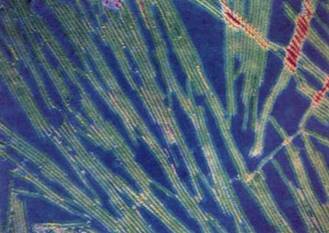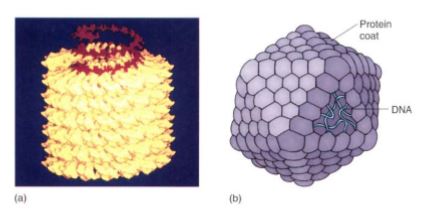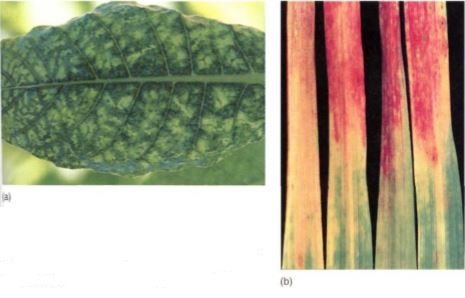


 النبات
النبات
 الحيوان
الحيوان
 الأحياء المجهرية
الأحياء المجهرية
 علم الأمراض
علم الأمراض
 التقانة الإحيائية
التقانة الإحيائية
 التقنية الحيوية المكروبية
التقنية الحيوية المكروبية
 التقنية الحياتية النانوية
التقنية الحياتية النانوية
 علم الأجنة
علم الأجنة
 الأحياء الجزيئي
الأحياء الجزيئي
 علم وظائف الأعضاء
علم وظائف الأعضاء
 الغدد
الغدد
 المضادات الحيوية
المضادات الحيوية|
Read More
Date: 27-10-2015
Date: 16-10-2016
Date: 30-10-2016
|
Viruses in Plants
In the past, much of the emphasis in studying viruses in plants was on preventing the spread of virus diseases in crops. Now many viruses are especially interesting as possible vectors for plant genetic engineering. Also, because most are RNA viruses (described below), they contain many unusual enzymes that are useful for the experimental manipulation of nucleic acids.
VIRUS STRUCTURE
Viruses are extremely small particles that usually contain only protein and nucleic acid. They were originally discovered in 1892 as factors that cause disease but were so small that they could not be seen with a microscope and could pass easily through filters with fine enough pores to trap even bacteria. They were never actually seen until the development of the electron microscope (Fig. 1). They were originally thought to be very small cells, but now we know that is not true: They have no protoplasm, no organelles, and no membranes. They cannot carry out their own metabolism independently—they must always parasitize cells of some sort. The great majority of viruses, especially those that attack plants, consist of only one or a few types of proteins and a small amount of nucleic acid (Fig. 2).

FIGURE 1:Tobacco mosaic virus particles are long, narrow filaments. In this preparation, viruses have been isolated from plant cells, washed, and treated with heavy metals to make them visible in an electron microscope (X 180,000). (Dennis Kunke/ Phototake NYC)

FIGURE 2: Most viruses, but especially plant viruses, are extremely simple.(a) Tobacco mosaic virus contains only one type of protein, which binds to the DNA, forming the long rod. In this form the DNA is j well protected. (Courtesy of G. Stubbs, K Namba, Vanderbilt University, and D. Caspar, Brandeis University) (b) In the virus shown here, the protein does not bind so closely to the nucleic acid but rather forms a coat, often called a capsid, around the nucleic acid.
Plant viruses always have a simple morphology, either long or short rods or even round particles. Tobacco mosaic viruses are rods 15 X 300 nm, whereas citrus tristeza viruses are rods up to 2000 nm long. Spherical or polyhedral virus are common, often having a diameter of about 60 nm. The diversity of nucleic acids in plant viruses is great. Of the known viruses, the greatest number (400) are retroviruses, which contain single-stranded RNA. Retroviruses are our source of reverse transcriptases, needed to make cDNA. Many of the viruses fat cause cancer in humans are animal retroviruses. Twelve known plant viruses have double-stranded DNA, and there are two groups of unusual types: 10 contain double-stranded RNA and 15 contain single-stranded DNA. Furthermore, many plant viruses are split genome viruses—not all of their nucleic acid is packaged as one particle. Instead the virus consists of at least two different particles, and both must be transmitted to a new host cell for viral metabolism to occur. Alfalfa mosaic virus consists of four distinct particles.
Most plant viruses have enough nucleic acid to code for only a very small number of proteins. Tobacco mosaic virus contains only 6400 nucleotides; its one and only coat protein contains 158 amino acids, so a minimum of 158 X 3 = 474 nucleotides are needed just lor that. Three other genes exist in this virus; two large ones code for replicase enzymes and a smaller one codes for a protein thought to mediate spread of the virus from cell to cell. Most other plant viruses are similarly small.
PLANT DISEASES CAUSED BY VIRUSES
Plants suffer from at least a thousand different virus-caused diseases. Because symptoms are similar to those of mineral deficiency or other environmentally caused problems, detection can be difficult(Fig.3) . Few effective treatments exist for plants infected with viruse. We do not try to cure whole crops of viral disease; rather we try to maintain healthy, uninfected breeding stock for virus-free seeds or cuttings. Antiviral drugs such as ribavirin appear to have cured some plants of virus infection, and gibberellic acid at least counteracts virus disease symptoms in some cases. Heat treatment inactivates some viruses; whole plants can be kept in hot (35 to 40°C) growth chambers or greenhouses for several weeks to several months, after which they may be free of virus. Even these techniques are ineffective in most plants and against most virus diseases; the best policy is to use virus-free plants and protect them from infection. Virus-free plants are obtained by shoot meristem propagation or sometimes by normal sexual production of seeds, if stamens and carpels can grow and set seed more rapidly than virus particles can infect them.

FIGURE 3: (a) This tobacco is infected with TMV. (Runk/Schoenberger from Grant Heilman) (b) Oat leaves infected with barley yellow dwarf virus. (Holt Studios, Ltd./Earth Scenes)



|
|
|
|
دراسة: إجراء واحد لتقليل المخاطر الجينية للوفاة المبكرة
|
|
|
|
|
|
|
"الملح والماء" يمهدان الطريق لأجهزة كمبيوتر تحاكي الدماغ البشري
|
|
|
|
|
|
جمعيّة العميد وقسم الشؤون الفكريّة تدعوان الباحثين للمشاركة في الملتقى العلمي الوطني الأوّل
|
|
|
|
الأمين العام المساعد لجامعة الدول العربية السابق: جناح جمعية العميد في معرض تونس ثمين بإصداراته
|
|
|
|
المجمع العلمي يستأنف فعاليات محفل منابر النور في واسط
|
|
|
|
برعاية العتبة العباسيّة المقدّسة فرقة العبّاس (عليه السلام) تُقيم معرضًا يوثّق انتصاراتها في قرية البشير بمحافظة كركوك
|